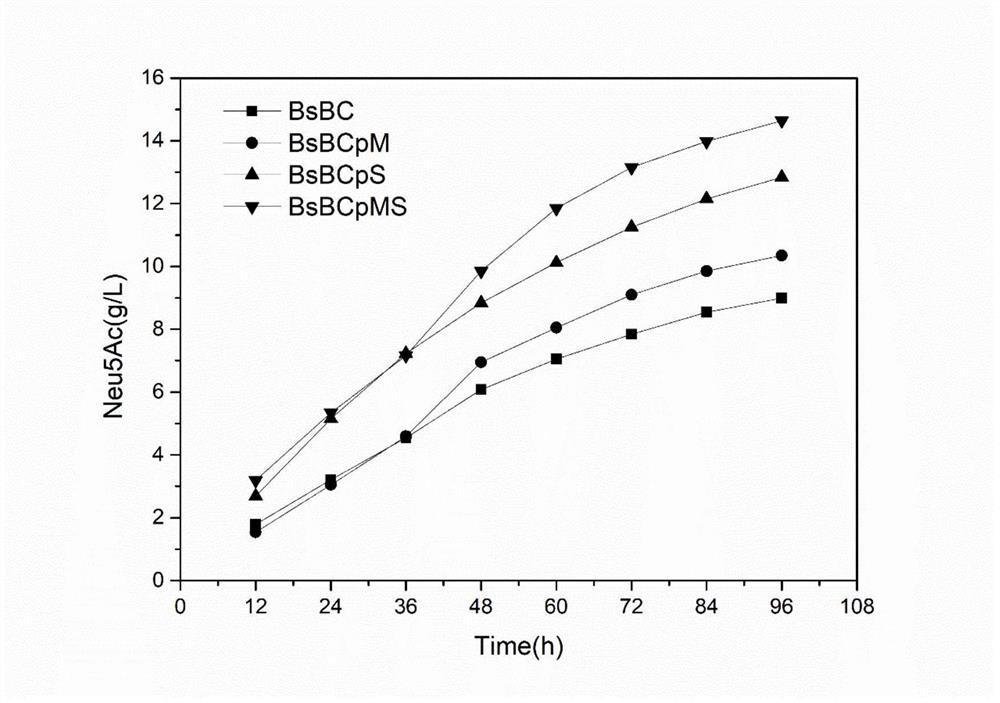Recombinant bacillus subtilis with high yield of N-acetylneuraminic acid, and construction method and application of recombinant bacillus subtilis
A technology of Bacillus subtilis and acetylneuraminic acid, which is applied in the field of bioengineering, can solve problems such as safety issues, and achieve the effects of no endotoxin, environmental friendliness, and simple production process
- Summary
- Abstract
- Description
- Claims
- Application Information
AI Technical Summary
Problems solved by technology
Method used
Image
Examples
Embodiment 1
[0038] Example 1: Construction of recombinant strain Bs-neuBC expressing neuBC gene on the genome
[0039] 1. The neuBC gene integration plasmid pJOE8999-gRNA-L-P grac - Construction of neuBC-R
[0040] 1) Synthesize the neuBC gene according to the neuBC gene sequence (GenBank No.AF100048), and add BamHI and XbaI sites at both ends;
[0041] 2) Digest the synthesized gene fragment with BamHI and XbaI, and recover it for later use;
[0042] 3) The expression plasmid pHT01 was extracted, digested with BamHI and XbaI, and recovered for later use;
[0043] 4) Ligate the above-mentioned enzyme-cut and purified vectors and fragments, connect them with T4DNA ligase, and transfer them into Escherichia coli DH5α competent cells to obtain the expression vector pHT01-neuBC;
[0044] 5) Enter the amyE amylase gene sequence into the website http: / / chopchop.cbu.uib.no / , and calculate the best gRNA sequence, which is TGAAGATCAGGCTATCACTG (SEQ ID NO.5);
[0045] 6) Using the total DNA of ...
Embodiment 2
[0058] Embodiment 2: Construction of glmS gene expression vector
[0059] 1) Design primers according to the glmS gene in the total DNA gene sequence of E.coli and its upstream and downstream sequences, and the forward primer is F-BamHI-glmS: GGATCC ATGTGTGGAATTGTTGGCGCG (SEQ ID NO.17) and reverse primer R-XbaI-glmS: TCTAGA TTACTCAACCGTAACCGATTTTGCCAGGT (SEQ ID NO.18), a BamHI restriction site is added before the forward primer, and an XbaI restriction site is added before the reverse primer;
[0060] 2) Using the total DNA of E.coli as a template, the glmS fragment (SEQ ID NO.19) was obtained by PCR amplification with the above primers (shown in SEQ ID NO.17-18);
[0061] 3) The plasmid pHT01 and glmS fragments were digested with BamHI and XbaI, recovered and ligated with T4DNA ligase, and transformed into E. coli DH5α competent cells to obtain the expression vector pHT01-glmS.
Embodiment 3
[0062] Embodiment 3: the construction of glmM gene expression vector
[0063] 1) Design primers according to the glmS gene in the total DNA gene sequence of B. subtilis and its upstream and downstream sequences, and the forward primer is F-BamHI-glmM: GGATCC ATGGGCAAGTATTTTGGAACAGACGGTGTA A (SEQ ID NO. 20) and reverse primer R-XbaI-glmM: TCTAGA TTACTCTAATCCCATTTCTGAC CGGA (SEQ ID NO.21), a BamHI restriction site is added before the forward primer, and an XbaI restriction site is added before the reverse primer;
[0064] 2) Using the total DNA of B. subtilis as a template, the glmM (SEQ ID NO.22) fragment was obtained by PCR amplification with the above primers (shown in SEQ ID NO.20-21);
[0065] 3) The plasmid pHT01 and glmM fragments were digested with BamHI and XbaI, recovered and ligated with T4DNA ligase, and transformed into E. coli DH5α competent cells to obtain the expression vector pHT01-glmM.
PUM
 Login to View More
Login to View More Abstract
Description
Claims
Application Information
 Login to View More
Login to View More - R&D
- Intellectual Property
- Life Sciences
- Materials
- Tech Scout
- Unparalleled Data Quality
- Higher Quality Content
- 60% Fewer Hallucinations
Browse by: Latest US Patents, China's latest patents, Technical Efficacy Thesaurus, Application Domain, Technology Topic, Popular Technical Reports.
© 2025 PatSnap. All rights reserved.Legal|Privacy policy|Modern Slavery Act Transparency Statement|Sitemap|About US| Contact US: help@patsnap.com



